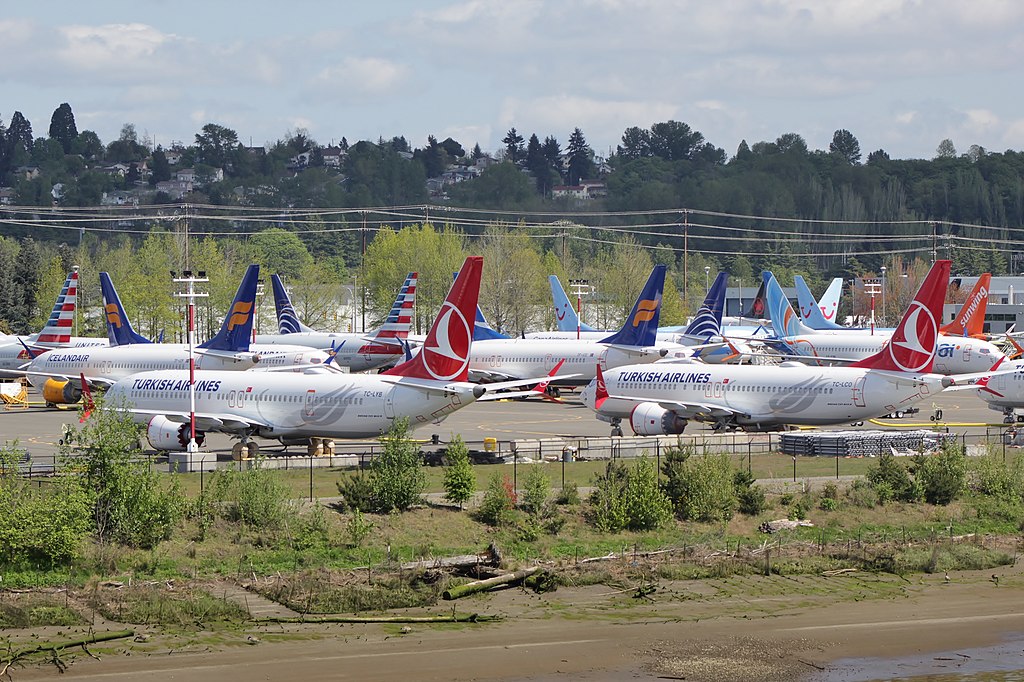Leeham News and Analysis
There's more to real news than a news release.
Widebody availability set to surge; could new entrants take advantage?
Subscription Required
By Judson Rollins
Introduction
June 3, 2021, © Leeham News: Lessors are expected to write down the value of their widebodies as the long-haul travel slump appears set to extend well beyond this year, LNA reported last week.
A tidal wave of excess widebodies has reduced ownership costs to historic lows. Prices will only go lower as lessors finally initiate distressed-asset sales, and lease rates will continue to fall as used widebody inventory grows.
A confluence of factors, topped by the availability of lower-cost used widebodies, could increase the cost advantage of low-cost carriers over legacy competitors – at the same time reduced business travel and lower yields reduce the gap between legacy and LCC unit revenue.
Summary
- Widebody availability is set to increase steadily throughout the decade.
- What airplanes are likely to be most attractive?
- Sustainably lower costs could enable low-cost carriers to overcome a shrunken “revenue gap.”
Widebody write-downs are coming – how much will asset values be affected?
Subscription Required
By Judson Rollins
Introduction
May 27, 2021, © Leeham News: As central banks pumped liquidity into the global economy over the past 15 months, aviation has attracted a steady stream of investor interest.
However, aircraft transactions have been few and far between apart from growth in sale-leasebacks. An expected wave of lessor consolidation has been limited to one major transaction, the AerCap/GECAS merger announced in March. Even this was likely driven by GECAS parent General Electric’s push to dismantle its finance business, GE Capital.
Fly Leasing, a lessor with just 84 aircraft, sold itself to private equity firm Carlyle Aviation Partners in March. These have been the only lessor mergers or acquisitions to date, despite wide speculation the COVID pandemic would spur many lessors to combine.
A lack of merger activity is likely because aircraft leasing is not a business with large economies of scale.
Widebody aircraft values have fallen 30%-40% since the start of 2020, according to the UK appraiser Ishka. Relatively few of these aircraft have been written down on lessor balance sheets, but more are expected to be so toward the end of this year.
Summary
- Equity investors looking for high returns are finding disappointment so far.
- Asset write-downs are unlikely to have much impact on lessor viability – but could open the door to distressed sales.
- Could a glut of unused widebodies lead to a wave of new airlines?
Global airline recovery is patchy, driven by domestic traffic
Subscription Required
By Judson Rollins
Introduction
May 20, 2021, © Leeham News: Despite widespread hope, the global passenger travel recovery many expected in 2021 has proven elusive to date. Airline industry advocate International Air Transport Association (IATA) said that March global passenger traffic was still down more than two-thirds from 2019.
First-quarter airline earnings in most parts of the world have been lackluster or worse as borders remain closed and business travel continues to be deeply depressed, even within the few countries where vaccine rollouts have made the greatest progress. And jet fuel prices have rebounded to nearly where they were before the pandemic.
Traffic volumes are rapidly growing in the US and Chinese domestic markets, but US carriers are reporting average yields 20%-30% below pre-COVID levels. Chinese carriers don’t provide any visibility into their yields. Forward booking data from IATA shows the domestic-international divergence will only widen in the coming months.
Air cargo continues to cushion the fall in passenger revenue at many airlines, but to nowhere near the extent necessary to fully offset it.
Summary
- International travel continues to weigh on airline earnings globally.
- US carriers are optimistic about the strength of leisure recovery, less so on business.
- Asia and Australasia remain largely isolated due to strict border controls.
- EU internal borders are slowly reopening; vaccinated travelers likely to be admitted soon.
- Cargo provides a revenue offset to some regions, but not all.
The SpaceJet impact on MHI’s finances
Subscription Required
By Vincent Valery
Introduction
May 17, 2021, © Leeham News: Mitsubishi Heavy Industries (MHI) officially launched the Mitsubishi Regional Jet (MRJ) program on March 28, 2008, at the end of its 2007 fiscal year. The Japanese industrial conglomerate envisioned the maiden delivery in 2013.
Fast forward 13 years, and the now-called SpaceJet development has been “paused” indefinitely. Most believe MHI effectively canceled the program. There is a possibility MHI might never bring the SpaceJet into passenger service.
LNA investigated MHI’s financial statements since 2005 and annual reports since 2007 to understand the impact of the program on the Group. This article takes a deep dive into the sequence of events, from launch to the COVID-19 pandemic, that led to the current state of affairs for the SpaceJet program.
Summary
- Becoming an OEM at the peak of the commercial aviation cycle;
- Repeatedly shifting program timelines;
- Solid MHI balance sheet funds project;
- COVID-19 pandemic tips balance after significant investments;
- A SpaceJet in limbo.
2021 fleet trends: small jets get bigger, bigger jets get smaller – and the old makes way for the new
Subscription Required
By Judson Rollins
Introduction
May 13, 2021, © Leeham News: Aviation data provider Cirium said last week that just under 7,850 commercial aircraft were still in storage, down from 8,684 at the beginning of the year and a peak of 16,522 at the apex of the COVID-19 crisis last April.
Although there was an initial spike in aircraft retirements in March and April 2020, the total number has stayed in line with historical norms to date. However, order books for most types have stagnated or even gone backward since the start of the pandemic.
A few trends are becoming clear: larger single-aisles are thriving, larger twin-aisles are disappearing, and sub-100-seat orders are flatlining. Not surprisingly, older-generation aircraft are disappearing at an accelerated rate.
Summary
- Airlines are upgauging their single-aisle orders in anticipation of lower yields and competitive battles.
- Widebody order books continue to struggle; the bigger the airplane, the worse the demand.
- Regional jet and turboprop order backlogs have stagnated.
NBA Single or Dual Aisle Airline preferences
Subscription Required
By Vincent Valery
Introduction
May 10, 2021, © Leeham News: Boeing has been studying the launch of a clean-sheet design aircraft for at least a decade. Studies included a single-aisle design but favored a twin-aisle concept before the 737 MAX launch in 2011. As time went on, the twin-aisle concept morphed into a focus on 767-sized dual-aisle with the New Midmarket Airplane (NMA).
The combination of the 737 MAX crisis, Calhoun’s arrival as CEO, and the COVID-19 pandemic led Boeing to shelve plans to launch the NMA in early 2020. However, the American OEM hasn’t stood idle despite sizable layoffs and R&D budget cuts.
LNA reported Boeing’s renewed focus on dual-aisle design and production systems and studied the tradeoffs between a single- and dual-aisle. The NMA has morphed into the concept of a New Boeing Airplane (NBA).
A critical mass of airlines needs to be willing and able to buy a new aircraft to justify a launch. Most observers agree that Boeing needs to launch a new plane to address the weakening market share in the large single-aisle market. However, there isn’t a consensus whether a single- or dual-aisle is the way to go.
LNA analyses in this article the design preferences of the airlines that could be interested in the NBA.
Summary
- Dual-aisle preferences;
- Different opinions about the required range;
- Low-cost carrier preferences;
- Lessor preferences.
China’s air travel “recovery:” volume improving, but revenue still elusive
Subscription Required
By Judson Rollins
Introduction
May 6, 2021, © Leeham News: In a media briefing this week, the International Air Transport Association (IATA) showed a deep contrast between the airline landscapes in the US and China versus the rest of the world.
The two countries together delivered 55% of the world’s domestic passenger traffic in March, with Chinese domestic capacity approaching 100% of pre-pandemic levels. China’s three largest carriers – Air China, China Eastern Airlines, and China Southern Airlines – are matching their US peers by deploying A350s and 787s on domestic routes, as most international routes to/from China remain closed.
However, first-quarter data continued to paint an ugly picture as unit revenue, or revenue per available seat-kilometer (RASK), was down at every publicly-traded carrier. Some of this was due to reduced load factors in January and February, but a key driver is the ongoing sale of “all you can fly” passes on most Chinese airlines.
Summary
- Domestic load factors have picked up, but international traffic near non-existent.
- First quarter financial reports show unit revenue fell below even last year’s abysmal levels.
- “Airpass” promotions continue, but it’s unclear how long they will go on.
- Fleet utilization during COVID: widebodies down but not out.
Uneven financial challenges among OEMs
Subscription Required
By Vincent Valery
Introduction
May 3, 2021, © Leeham News: The three largest commercial aircraft OEMs and their largest suppliers continue to report impacts from the COVID-19 pandemic in their 2020 financial results.
The pandemic and its impact on airlines’ bottom line is rippling through Airbus, Boeing, Embraer, and their suppliers.
LNA collected financial information on the big three aircraft manufacturers and seven major commercial aircraft suppliers. The impact on each company varied significantly on their earnings, cashflows, and balance sheet.
Summary
- Cashflow and charge challenges at aircraft OEMs;
- Engine OEMs feeling the pressure;
- A more benign picture for other large suppliers;
- Goodwill monitoring.
Why the MAX isn’t back – yet
Subscription Required
By Judson Rollins
Introduction
April 29, 2021, © Leeham News: Much virtual ink has been spilled in recent weeks over an apparent surge in demand for Boeing’s 737 MAX, as a slow drip-drip-drip of cancellations finally reversed into net new orders.
The Boeing team must be grateful to see a shift toward positive headlines for its single-aisle family. Longtime 737 customers provided badly needed votes of confidence with top-ups to their previous orders.
However, such momentum has been slowed by a continuing wave of cancellations. Boeing logged just 12 net orders in February and 40 in March. More cancellations are due to be announced; Turkish Airlines recently said it would cancel or convert to options 50 of its previous MAX orders, and ch-aviation says a single unidentified customer cancelled another 45 in March. Aeromexico swapped MAX orders for other MAX orders, saving $2bn in the process – a revenue hit for Boeing down the line.
The total backlog, net of orders in doubt under ASC 606, is down from a high of 4,708 to just 3,240 as of this week. This is enough to support average production of just 30 airplanes per month through 2029. Boeing CEO David Calhoun said on yesterday’s earnings call that he remains confident the MAX demand will recover from this point forward.
Summary
- New orders are mostly from large existing MAX customers, and likely include mitigation discounts for delivery delays.
- Boeing has 400 undelivered aircraft in storage, some of which were due for delivery to now-defunct airlines.
- Pricing trends are quite negative, depriving Boeing of badly-needed free cash flow.





